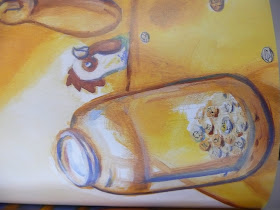Some of the little ones are interested in hockey. One of the teachers has created a small hockey pool, just to have the fun of cheering on one of the teams as they work hard to become Stanley Cup playoffs. We are officially cheering for the Pittsburgh Penguins!
I don't think that this feeble attempt will actually convince you that Ryan Smith came to our classroom, but this little guy got to meet him at his hockey practise and if you look closely, you'll see that his hat has a special signature on it! Congratulations!
Here's the silly book that led our mathematics and money investigation this week.
The following spring, the tree has a coin in each of the flower buds depending on the type of fertilizer used. The challenge was to figure out how much money would be found in the jar after 100 pennies, 100 nickels, 100 dimes and 100 quarters were stored inside.
As important as the final solution is, the most important part is to hear how the students went about their problem solving. What do they already know that can assist them in finding the answer? Many of them did not think about using the 100 chart to help. How could it help? In the picture of the SMARTBoard you can see that the students recognized that knowing how many of each coin adds up to $1.00 was also something important to know. Often the students are asked to talk about these challenges at home with their families. It gives them a chance to try out their ideas. It is not absolutely necessary that they have a correct solution, but it is important that they get to talk in a safe environment and what is safer than home!!??
In the afternoon on Friday, the students were faced with another challenge. After looking at the finished 'Wild Thing' head, the students thought about how they would make each of the parts of the face. This allowed them to see their own problem solving skills, allowed them to focus on the size and shape of the various components, demonstrated their ability to create shapes without a tracer and be proud of their finished product.
Writing a descriptive paragraph is next on the list of things to learn!









No comments:
Post a Comment